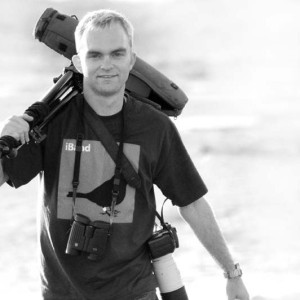“Noah Strycker: Birder at Large” is a pretty cool business card, but it only hints at the extent of Strycker’s avian adventures. The naturalist, artist, and journalist has explored the world – including extended stints with penguins in Antarctica – studying and documenting birds.
As he explains to Brendan, his new book, “The Thing with Feathers: The Surprising Lives of Birds and What They Reveal About Being Human,” expands our view from simply observing creatures, to sharing what they can teach us about nature, intelligence, memory, and other important themes.


Brendan Francis Newnam: It’s time for chattering class. This is the part of the show where we get schooled in a party-worthy party topic. Today our subject is birds, and our expert is Noah Strycker. He is associate editor of Birding Magazine and a frequent contributor to other bird-related publications. He has spotted 2,500 birds on 6 continents — that’s one fifth of all the world’s species — and he’s only 26.
Noah you are truly, as you say in the book, a bird nerd.
Noah Strycker: Yes, that is how I reply when people ask me what I do. I say “full-time bird nerd.”
Brendan Francis Newnam: Let’s start with albatrosses. You think they can teach us about love. Why?
Noah Strycker: Scientists have studied divorce rates — if you want to call it that — in albatrosses as being as low as point-one percent. In other words, only .1% of albatross pairs will split up before one of them eventually dies. You look at human divorce rates around the world, by contrast, are around 40% to 45%, and that puts us at about the same romantic level as a seabird called the Nazca Booby, for what it’s worth.
Brendan Francis Newnam: Well then maybe they’re just co-dependent. How do we know it’s love?
Noah Strycker: Well I should note that that is social monogamy and not necessarily sexual monogamy. So there’re a few things going on on the side. But they do stick together, and that may have something to do with the fact that albatrosses live a long time, just like we do. An albatross might live between 50 and 100 years. We don’t even really know because we haven’t studied individual albatrosses that long yet, but we think so.
Brendan Francis Newnam: And what I found remarkable: Albatrosses spend much of their lives over open water, alone, and yet they come back every couple years and they meet their mate from decades and decades before, and they both know to meet each other.
Noah Strycker: It’s amazing. We still don’t know how they do it because, yes, while they’re not nesting, albatrosses spend their whole lives over the open ocean. A typical albatross will fly several million miles in its life. And that’s like going from the earth to the moon and back 10 or 12 times, which is pretty crazy. That’s farther than any car that humans have ever built.
Flying for albatrosses is just amazingly easy. They have this special tendon in their shoulder that locks their wing out like a switchblade. It’s pretty much like sitting still for them. Scientists have tried to come up with how much energy it takes an albatross to fly and they’ve come up with, basically, zero.
Brendan Francis Newnam: All right, on from the albatross to the starling. And this is a bird that’s one of the most plentiful in the United States. Many people consider it a nuisance. I was surprised to find out that starlings aren’t native to North America.
Noah Strycker: So the story goes that European starlings — and another bird called a house sparrow, which is also very common in US cities now and also widely hated — were introduced originally because someone was trying to introduce all of the birds to North America that were mentioned in the collected works of Shakespeare. They wanted to take all the birds that they were familiar with from back home, and add them to the North American avafauna. And it may or may not be true, but there definitely was this push 100, 150 years ago to add birds from the old world to the new world because, in those days, they thought it would improve the bird life of North America.
Brendan Francis Newnam: The complete opposite.
Noah Strycker: It was a terrible idea. Most of the birds they brought over here didn’t survive, but the ones that did sort of took over, kind of like starlings.
Brendan Francis Newnam: And wasn’t there this one New York pharmacist who was credited with bringing them over?
Noah Strycker: There was this one guy who made it his mission to introduce starlings to New York City, and it took him several efforts. The first few lots just perished and died and froze to death, as they do in New York City. But finally a few birds took hold and just ran with it.
Brendan Francis Newnam: Well speaking of popular birds, I was surprised when I was reading your book that there was a section on chickens, because chickens are usually ignored by the larger birding community. They’re not considered as cool as wild birds.
Noah Strycker: The cool thing about chickens is actually the domestic chicken is the most abundant vertebrate in the world. There is no other species that has more numbers —there’s about 24 billion domestic chickens on earth.
Brendan Francis Newnam: That’s amazing.
Noah Strycker: The thing is, most of them don’t live very long. Just about 6 months or so on average.
Brendan Francis Newnam: That number is impressive, but then you think about Chicken McNuggets and stuff and you’re like, “Well, where does that get them?”
My favorite story in the chicken chapter is the guy that invented contact lenses for chickens.
Noah Strycker: This guy thought he was gonna be the most rich and famous man on earth because he had figured, he thought, how to solve chicken blood lust. Chickens go crazy over the color red. And this is really true; it’s not like bulls, which apparently can’t really process the color red and it’s the movement of the matador’s cape more than anything that drives them crazy. But chickens — it may be the color of blood or just some other random thing — but when they see red they can sometimes just flip a switch and go crazy and kill each other.
Brendan Francis Newnam: This is probably why we use mayonnaise instead of ketchup when we eat them. We don’t want to awaken them.
Noah Strycker: This guy had seen a lot of farmers using red lights in their chicken coop, because the theory went that if everything was bathed in this red glow, then chickens wouldn’t be able to tell which things were red and which weren’t, and so they wouldn’t attack any particular bird or anything like that. What he decided to do was to try to mess with the chickens’ vision to make it so that the chickens themselves were seeing everything red, and so they wouldn’t need to install these low lights in the chicken coops which made it hard for the farmers to see what they were doing. So he figured out a way to design red contact lenses for chickens. And you could put these in the birds eyeballs and everything the bird saw would be red. So it didn’t really work out in the end.
Brendan Francis Newnam: What could possibly go wrong?!
Noah Strycker: Imagine trying to hold down a chicken, with a tiny little contact lens on your finger, and stabbing it into the birds eye. That was the first problem, and the farmers hated doing this. The second problem was, well, it turned out these contact lenses irritated the birds eyeballs so much that they were just anxious and mad all the time, and they ended up having more blood lust in the end, not less.
Brendan Francis Newnam: They could have use soy sauce as lens solution to kind of, you know —
Noah Strycker: Pre-flavoring!
Brendan Francis Newnam: That’s right; made for a tastier bird in the end.


